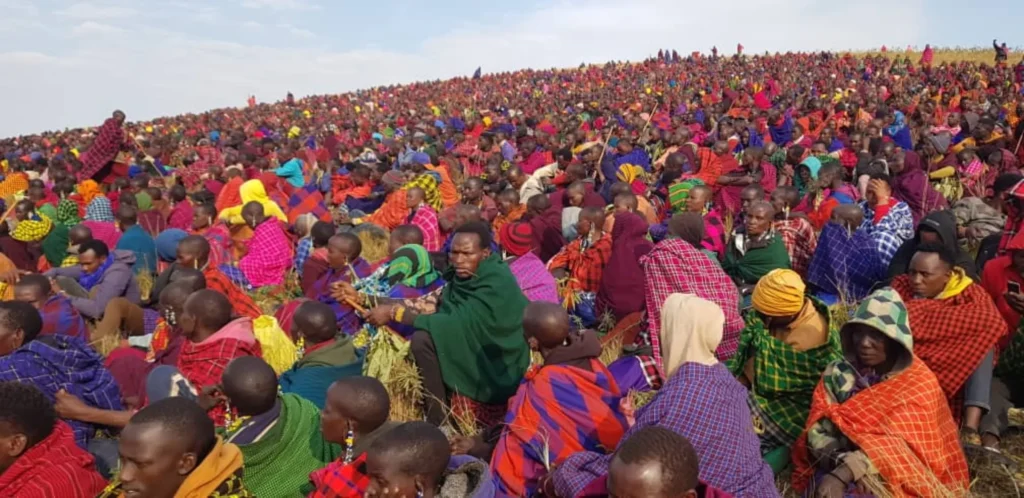
Communities have been forcibly removed from their lands in Tanzania for a long and disturbing time. The expansion of protected conservation areas, which comprise more than 40% of its land, has been the pretext for this.
These evictions have recently targeted the Maasai of the Ngorongoro district, which is known for its rich wildlife and the famous Ngorongoro Crater. Their nomadic way of life, which is centered on herding livestock, has been threatened.
The evictions, according to the administration, are required to safeguard the environment from a sizable Maasai population. Presently, the protected area is home to about 100,000 Maasai.
In actuality, though, the government is denying the Maasai their right to use that land. After then, the land is leased to develop premium hunting areas and lucrative wildlife tourism. Wildlife-driven tourism accounts for more than 17% of the nation’s GDP. Since taking office in 2021, Samia Suluhu Hassan has increased the frequency, severity, and scope of evictions. Government soldiers have shot, imprisoned, and mistreated Maasai people in recent years. Academics, campaigners, and local communities have all expressed outrage about this.
Maria Tsehai, a well-known Tanzanian activist who was kidnapped and then freed in Nairobi, Kenya, is one of these voices. Her kidnapping, which was probably a component of a larger assault on critics of the Tanzanian government, has brought attention to the persecution of people who disagree with plans to relocate Maasai villages.
I have studied Tanzania and other east African countries’ conservation policies and practices for a number of years.
I examined how Tanzanian authorities, along with international conservation and tourism players, have imposed laws that force Maasai populations to leave their ancestral lands in a 2022 study. Plans for conservation management that compromise the interests of regional communities and customary means of subsistence were used to achieve this. By limiting their access to social services, for example, the Maasai were also unable to adequately address their requirements.
Because of this, almost all of the 100,000 Maasai who reside in the Ngorongoro reserve area live in abject poverty.
They are being evicted from their ancestral lands on the grounds of poverty.
For ‘conservation’, evictions
The Ngorongoro Conservation Area was created in the late 1950s with the dual goals of protecting Maasai interests and conserving wildlife. There were roughly 8,000 people living there at the time.
Over time, the Maasai community’s interests were purposefully neglected and undercut by successive policies. This has been going on for over 60 years.
According to local media, 9,778 residents have moved out of the conservation area since 2022. However, the goal is to finally remove the majority.
This has been aided by international conservation organizations like Unesco (the United Nations Educational, Scientific, and Cultural Organization) and the Frankfurt Zoological Society. The Tanzanian government was able to defend its infringement of Maasai rights within the conservation area because to the narratives they supplied.
From the beginning of the creation of the protected area, Bernhard Grzimek, the former director of the Frankfurt Zoological Society, in particular, pushed for the expulsion of the Maasai.
The Tanzanian government was also asked to “voluntarily” transfer populations by “increasing incentives to relocate” in evaluation reports from Unesco’s World Heritage Committee. The conservation area’s designation as a world heritage site explains this.
The evictions are also the result of complicity by tourism actors. They can view the Maasai as rivals for resources like water or as an annoyance.
Methods of removal
The Maasai are forced to relocate by a number of measures.
First, the conservation area permits local communities to reside there, although this is legally subject to their rigorous adherence to nomadic pastoralism. Conservation of animals is thought to be compatible with pastoralist lifestyles. This implies that the Maasai are dependent on seasonal migration and can only stay in the region as cattle breeders. Most permanent settlements are forbidden. The Maasai are unable to diversify their sources of income beyond raising livestock because of these circumstances. Second, while authorities support traditional pastoralism, they also work against it. Laws limit their mobility; for example, they are only allowed to graze in specific locations. There is restricted access to vital water sources and grazing areas during the dry season. These are essential conditions for pastoral nomadic living. Consequently, pastoralism’s production has sharply decreased.
Third, social services have long been denied to the Maasai communities in the reserve area. Health and education are included in this. Additionally hindered are governmental and other actors’ investments in social infrastructure, including hospitals and schools.
The Maasai’s eviction is being justified by the poverty they experience as a result of these policies. Nearly 74% of people lack a formal education, and over 80% of people live below the poverty level. Resettlement, according to authorities, is best for the Maasai. As a result, these strategies have increased the Maasai’s susceptibility to displacement and made it simpler to seize their property. Poor and marginalized, many Maasai are forced into “voluntary” resettlement or move on their own initiative.
Injustices pertaining to conservation
The continued eviction and mistreatment of Tanzania’s Maasai and other groups calls into doubt state authority, local community rights, and international conservation priorities.
This is not specific to Tanzania or the Ngorongoro conservation area. Under the pretense of protecting the environment, similar land grabs and evictions of marginalized populations are taking place all around the world. The push to increase the number of protected areas has accelerated as concerns about biodiversity loss grow on a worldwide scale.
These conservation initiatives frequently conceal power relations that lead to the eviction of marginalized communities. Examining the local implementation of these policies is essential.
Such programs run the risk of escalating the very disparities and biodiversity loss they purport to address if accountability and true community involvement are lacking.







